#handynasty
Photo

China in World History (New Oxford World History series)
This is a volume in the New Oxford World History series. According to the Editor’s Preface, the aim of this series is to "offer readers an informed, up-to-date and lively history of the world" that avoids the ethnocentric bias of traditional "world histories" of only focusing on Europe and the United States. This series contains three types of books. First, eight books in the series deal with different periods in world history. Second, certain volumes concern world history using a thematic perspective, focusing on topics such as city, democracy, technology, migration, etc. Finally, there are books that deal with specific countries or regions, and Paul S. Ropp's China in World History belongs to this category.
... the book is a helpful introduction for anyone unfamiliar with Chinese history.
In the book, Ropp states that his goal is to provide an account of Chinese history that places China in a global context. To do this, he focuses on China's historical interactions with foreign countries and compares aspects of Chinese society with others around the world. The book is divided into nine chapters that examine Chinese history in chronological order. Chapter One deals with the earliest periods up to the 3rd century BCE. Chapter Two describes the Qin and Han dynasties (221 BCE - 220 CE). Chapter Three explores the period of disunity from 220 to 589 CE. Chapter Four examines the reunification of China under the Sui and Tang dynasties (618 - 907 CE). Chapter Five recounts events during the Song and Yuan periods (960 - 1368 CE). Chapter Six looks at the early modern period of the Ming and early Qing dynasties (1368 - 1800 CE). Chapter Seven describes the fall and aftermath of the Qing dynasty (1800 - 1920 CE). Chapter Eight deals with the period from 1920 to 1949 and looks at the civil wars, the Japanese invasion, and the rise of the Communist Party. The last chapter is about the People’s Republic of China from 1949 to today.
Continue reading...
20 notes
·
View notes
Photo
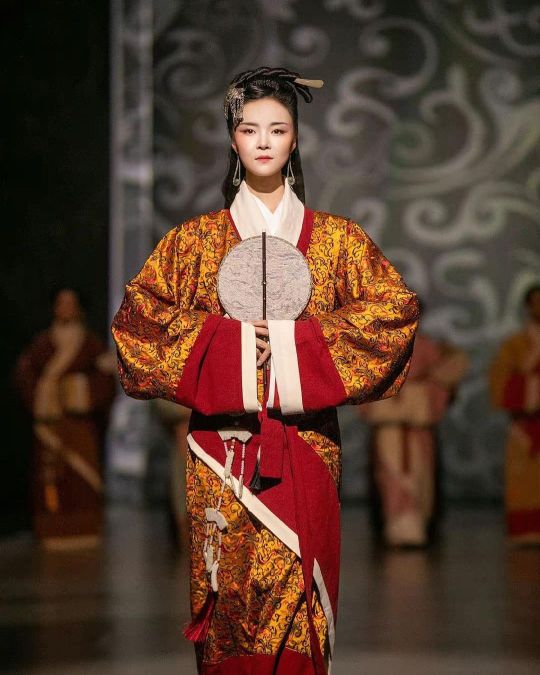
“When love has expired, I’m the useless fan in autumn to you.” ——— Consort Ban. Actress: Zhang WanQing 张婉清 Hanfu: Han Dynasty QuJu. #hanfu #hanfugirl #hanfudress #hanfuhairstyle #hanfufashion #chinesedress #美好年华研习社 #hanfu_challenge #stagecostume #chinesecostume #traditionalclothes #traditionalclothing #culturalheritage #intangibleculturalheritage #chineseculture #hanfufromchina #traditionalart #chinesehair #chineseaesthetic #handynasty #history #consortban #张婉清 #hairbun #hairbunstyle #costumejewelry #traditionalcostume #traditionalculture #hanfuhairpin #chineseaccessories https://www.instagram.com/p/CixJqw7puXo/?igshid=NGJjMDIxMWI=
#hanfu#hanfugirl#hanfudress#hanfuhairstyle#hanfufashion#chinesedress#美好年华研习社#hanfu_challenge#stagecostume#chinesecostume#traditionalclothes#traditionalclothing#culturalheritage#intangibleculturalheritage#chineseculture#hanfufromchina#traditionalart#chinesehair#chineseaesthetic#handynasty#history#consortban#张婉清#hairbun#hairbunstyle#costumejewelry#traditionalcostume#traditionalculture#hanfuhairpin#chineseaccessories
28 notes
·
View notes
Photo

Han Dynasty Weapons Rack with multiple types of weapons including 2 Long Swords on the top two racks.The man standing in front of the Rack has a Bow in one hand and a Hook Shield in the other.
#swordstand#handynasty#chineseswordsmanship#chineseswordfighting#chineseswordwork#chineseswordplay#chineseswordarts#chineseswordart
3 notes
·
View notes
Text
Historians Hate This One Fact About Ancient Fu Dog Statues

Introduction to Fu Dog Statues

Kicking off the captivating tale of the Foo Dog statue, it's important to delve into its roots. Foo Dogs, known as 'Fu Dogs', are classic symbols in Chinese culture, embracing history, craftsmanship, and vibrant folklore. These distinctive statues, formidable yet protective, are traditional elements gracing the entrances of temples, palaces, and homes in China. The statues depict mythical beasts that have an intrinsic appeal due to their rich symbolism and intriguing history, dating back to the Han Dynasty.
Typically, Foo Dog statues look like lions and are often called Chinese guardian lions in the west. This unique lion-like creature, which does not exist in the natural world, combines the formidable fearlessness of a lion with the loyal protectiveness of a dog. It's a potent and fascinating symbol in Chinese culture, amalgamating different elements that appeal to various life aspects.
These sculptures serve multiple purposes, including warding off negative energies, safeguarding spaces, and acting as a talisman for good fortune. Embarking on the exploration of the Foo Dog statue's history, design, and cultural impacts, one uncovers ancient legends and stories that reiterate its timeless value in Chinese culture.
Key Takeaways: Fu Dog Statues
- Fu Dog Statues, also known as Chinese Guardian Lions, have origins dating back to the Han Dynasty.
- These statues are not just artistic pieces but carry deep symbolism of protection, prosperity, and balance in Chinese culture.
- The male and female Fu Dogs represent different aspects, with the male symbolizing dominance and the female symbolizing nurture.
- Fu Dogs play a significant role in Feng Shui, believed to ward off negative energy and bring good luck.
- These statues have been adopted in various Asian cultures and have influenced Western art and architecture.
- A lesser-known fact is the transition of Fu Dog Statues from traditional materials to ceramics during the Tang dynasty, reflecting a cultural shift.
- Fu Dogs are often placed in pairs at entrances of temples and homes, serving as guardians against evil spirits.
- Their global popularity underscores their universal appeal and the widespread appreciation of Eastern cultures.
Definition and Origins

Fu dogs, often known as foo dogs, trace their origins back to the Han dynasty (206 BC - 220 AD) of China. Enigmatic yet captivating, they are not dogs at all, but rather powerful ancient Chinese protective symbols. They are depicted as majestic lion statues, drawing from the Asian cultural reverence for lions as the king of beasts and a symbol of power and protection.
The foo dog lion statue is a fascinating fusion of Buddhist and Taoist cultural influences. It represents the sacred animal lion from Buddhist folklore and embodies the Taoist principles of Yin and Yang, balance and harmony. To the untrained eye, fu dogs may appear identical; however, subtle differences distinguish the male and female figures, symbolizing the complementary forces of Yin and Yang.
Purpose and Symbolism

The foo fu dog statue, prominently visible in the East, is rich in purpose and symbolism. These statues originated from China's Han dynasty, drawing inspiration from ancient lion-based mythology. They were not just mere pieces of art but served an essential function in Chinese society. Their purpose was both spiritual and aesthetic, as these majestic and intricate sculptures were intended to protect individuals and their households from malevolent spirits and people.
Symbolism runs deep in foo fu dog statues. The pair usually consists of a male lion playing with an embroidered ball, symbolic of supremacy over the world, and a female lion nurturing a cub under her paw, representing the cycle of life. The grotesque yet profoundly artistic facial expressions are an embodiment of courage and fearlessness, warding off evil entities.
They also represent power, prosperity, and success, which is why they are ubiquitous in significant structures and residences. Thus, these statues are more than ornamental; they reflect the deeply ingrained Chinese philosophies about balance, protection, and the cyclical nature of life.
The foo fu dog statues are not just pieces of art, but they carry a heavy weight of purpose and symbolism that is deeply rooted in Chinese culture. These statues were originally created during the Han dynasty and have been used for centuries as symbols of protection and prosperity.
• The primary purpose of these statues was to serve as protectors. They were placed at entrances to buildings or homes to ward off evil spirits and people with malicious intent. This protective function is reflected in their fierce facial expressions which embody courage and fearlessness.
• In addition to their protective role, foo fu dog statues also served an aesthetic function. Their intricate designs make them visually appealing, adding a touch of elegance and majesty wherever they are placed.
• Symbolically, the male lion playing with an embroidered ball represents supremacy over the world while the female nurturing a cub under her paw symbolizes life's cyclical nature.
• Another layer of symbolism comes from their appearance; despite being grotesque, these sculptures embody power, prosperity, success - qualities highly valued by Chinese society.
In conclusion:
- Foo Fu Dog Statues represent more than ornamental figures; they reflect profound Chinese philosophies about balance, protection, life cycles.
- Despite having originated several centuries ago during China's Han Dynasty these majestic sculptures remain relevant today due to their deep-rooted significance.
- Their ubiquity in significant structures across East Asia testifies not only to their cultural importance but also underscores how integral these beliefs continue to be within contemporary societies.
Historical Significance
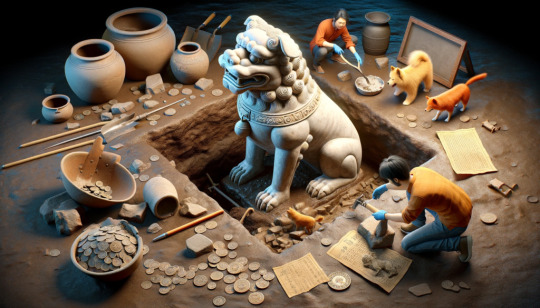
The prominence of the Fu dog, or, more accurately termed, the fu lion statue, can be traced back to Imperial China. Both the Han and Tang dynasties showcased them predominantly, but their significance grew much further during the Ming and Qing dynasties. During these eras, they were seen as the epitome of imperial power, courage, and regality, often strategically placed in important political and religious institutions. Notably, several imperial tombs were adorned with these statues, believed to guard the souls of the deceased rulers against evil and harm in the afterlife.
Han horse-shaped pottery covered with Fu lion designs reveals their artistic significance, highlighting their extensive use as motifs in pottery, paintings, tapestry, and architecture. The fu lion statue also boasted an immense artistic value, symbolizing prosperity and success, often given in the form of gifts to bestow good fortune.
As the culture diffused, so did the prevalence of these statues, spreading across other Asian nations and beyond. Today, they continue to signify courage, prosperity, and protection, maintaining their historical reverence. Their visually captivating aesthetics and deep cultural roots have played an influential role in tastefully blending the past with the present, retaining their historical significance over the centuries.
The Mysterious History of Fu Dogs

Diving deep into the annals of China’s rich and profound history, one will invariably cross paths with numerous stories and legends surrounding large Foo Dog statues. These mystical beasts, also known as Chinese guardian lions, have captivated the interests of scholars, historians, and art enthusiasts alike. Their impressive historical presence in Chinese culture dates back to the Han Dynasty (206 BC–220 AD).
Thought to have profound protective abilities, these large Foo Dog statues were a common sight at imperial palaces, tombs, temples, and homes of nobility. These majestic sculptures served not only as exquisite pieces of art but also as totems believed to ward off menacing spirits.
However, beyond the visual grandeur of large Foo Dog statues, lies a trove of inconceivable mysteries and untold stories waiting to be unearthed. The origins of these mythical creatures have always been a subject of debate, considering how deeply they have been embedded in Chinese folklore and mythology. Some theories suggest that they were inspired by Indian culture, while others propose their roots in Persian or Greek art.
Ancient Chinese epics discuss them as celestial beings, while many believe they were modeled after native dogs—one has to carefully sift through the layers of history to discern the factual evidence from myths. Nonetheless, the fascination with their undeniable historical significance keeps the enigma of Foo Dogs alive in the hearts of historians, writers, and beholders alike.
Ancient Chinese Legends
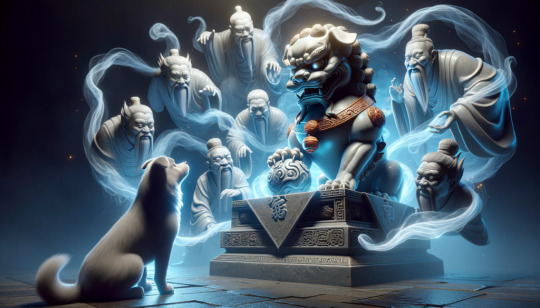
Steeped in deep traditions and narrated through generations, the folklore and legends surrounding the Chinese Foo Dog statues hold an exceptional mystique in ancient Chinese legends. They are not simply decorative sculptures but hold enormous cultural and symbolic significance.
It is said that these ancient guardians originated from the Han Dynasty, around 206 BCE to 220 AD. An intriguing aspect of these legends is that despite their commonly referred name 'Fu Dogs,' they are not dogs at all. Instead, they are mythical beasts, known in Chinese as Shi, symbolizing power and protection.
In ancient Chinese legends, Shi were believed to have an incredibly protective nature and the presence of their statues were seen as potent filters of bad fortune or malicious spirits. They stood as markers of divine power and protection at the gates of imperial palaces, government offices, temples, tombs, and homes of the affluent.
The distinctive features of the Chinese Foo Dog statues, with their menacing expressions and imposing physique, depict a fierce protective spirit. Their legend summons an image of fearless defenders and guardians, an enduring aspect that has been etched deeply in the legacy of ancient Chinese folklore.
Fu Dog Mythology and Folklore

Immerse deeply into the heart of Chinese folklore, and you'll encounter many tales centering around outdoor Fu Dog statues. Also known as Fu dogs or Lion dogs, these creatures have an enticing blend of the lion's majestic power and the loyal canine's protective spirit. Outdoor Fu Dog statues have a strong symbolic presence in many narratives, often credited with warding off evil spirits and welcoming positive energy at the entrances of homes and temples. This is why they are frequently seen as an essential part of Chinese architectural aesthetic, with prominence at the gate of monasteries, temples and palaces, as well as private villas and estates.
The folklore surrounding these mythical beings is rich and varied. Some stories depict them as menacing creatures whose sole purpose is to scare away evil spirits. Others portray them as nurturing creatures connected with fertility and abundance. The Fu dogs, usually depicted in pairs, are thus seen as the perfect balance of yin and yang energies, representing the dual forces that harmoniously regulate the universe's movement.
Often, the male Fu dog is portrayed playing with a ball, symbolizing the world's unity, while the female Fu dog is seen with a cub, symbolizing the cycle of life. Such visual storytelling invokes a sense of wonder, effortlessly tying together elements of nature, cosmology, and human existence in a beautifully succinct pictorial narrative.
Archaeological Evidence

Archaeological excavations in China have provided a trove of clues regarding the history and significance of the Fu Dog or Guardian Lion across various dynasties. Notably, amongst various artefacts, jade foo dogs have emerged as a recurrent theme, standing out for their intricate craftsmanship and rich symbolic value. The earliest evidence of jade foo dogs dates back to the Han Dynasty (206 BC–220 AD), when the practice of carving religious and mythological figures from jade was flourishing. Some historians speculate that the jade foo dogs of the Han era were not just objects of beauty, but also spiritual talismans believed to ward off evil spirits and bring prosperity.
In recent times, the Mausoleum of the Nanyue King in Guangzhou City, unearthed a significant number of jade artifacts including jade foo dogs, dated back to the Western Han period. These discoveries, carefully preserved and studied, help us understand the antiquity of foo dogs in Chinese culture as well as underlying historical craftsmanship techniques.
Further, it sheds light on the socio-cultural dynamics of the period, indicating how such artifacts were predominantly associated with power and protection. The meticulous detailing of these jade foo dogs underscores the high level of finesse that ancient Chinese artisans possessed and the symbolism that such artifacts carried in their era.
The Fact Historians Don't Want You to Know

Despite the well-documented history of Fu Dogs in Chinese culture and tradition, there exists a lesser-known fact that ceramic sculptures of these creatures carry a unique significance. When Fu Dog statues first appeared, they were made from bronze, stone, or wood, attributing to both the artistry and the resources available during the different dynasties. However, the craft saw a significant revolution at the onset of the Tang dynasty when foo dogs ceramic gained widespread popularity.
The rise in the foo dogs ceramic during the Tang dynasty is said to be due to the technological advancements in pottery, and ceramics at that time. Simultaneously, this trend reflected the increasing openness of Tang society, gradually moving away from the rigidly hierarchical Shang and Zhou societies and expressing this liberal phase through its art forms.
This historical shift, though quite compelling, is often understated, possibly because it disrupts the more engrained narrative of Fu Dogs as symbols of imperial power and authority. Instead, it highlights a period of evolution, when societal changes influenced art and culture in profound ways. This transformation is encapsulated in the transition from using traditional materials to ceramics for Fu Dog statues, a fact intriguingly unknown to many.
Fu Dog Design and Craftsmanship

Fu Dog Statues are distinguished by a meticulously detailed design and superior craftsmanship. This intricacy can be attributed to the centuries-old Chinese tradition of stone carving and pottery-making. The exquisite detail of Fu Dogs, from their curly mane to the wide-open jaws displaying sharp teeth, embodies not just aesthetics, but also folklore and mysticism tied to the creature.
The common physical features of Fu Dogs include a lion-like appearance, a bushy tail, and a protective and fierce demeanor. Often the Fu Dog sculpture depicts a pair, comprising one male with a ball under his paw (symbolizing the world's unity) and one female, with a cub under her paw (symbolizing nurture and the cycle of life).
Stylistic variations of Fu Dogs vary greatly based on region and era. Despite this, elements like the paw on the symbolic objects, aggressive expressions, and muscular, lion-like bodies remain constant in traditional designs. Fu Dogs are typically carved from marble, jade, bronze, or wood. Every material has its own significance, from purity symbolized by Jade to strength and durability associated with Bronze and Wood.
Sometimes the statues are enhanced with more detailed ornamentation, Oftentimes, the statues are painted or gilded to make them more visually striking. These intricacies in design and craftsmanship highly contribute to Fu Dogs' appreciation as exquisite pieces of art and cultural symbols.
Common Physical Features

Fu Dog statues are typically portrayed as majestic and ferocious mythical beasts, reflecting a harmonious blend of strength, elegance, and spirituality. The most universally recognized physical attributes consist of a bulging, muscular body, thick mane, and widely-opened jaws that reveal sharp, imposing teeth. They are typically shown with one foot raised and placed on an object. This object varies - it might be a cub depicting nurturance if the creature is female, or a ball symbolizing command and authority if the creature is male.
Coupled with the captivating presence of finely detailed fur, the piercing eyes of Fu Dogs contribute to their grandiosity, giving them an aura of wisdom curled with intensity. Another characteristic element of Fu Dogs is the vibrant and intricate adornments and the surface etchings on them.
Read the full article
#ancientChina#artandarchitecture#Asianart#Chineseculture#ChineseGuardianLions#Chinesemythology#culturalheritage#Easternphilosophies#FengShui#FuDogStatues#FuDogStatueshistory#globalinfluence#guardianlions#HanDynasty#TangDynasty
0 notes
Text
Dragon Blade | Action Movie | Must Watch for Jackie Chan Fans | Action, Drama, Fantasy

Jackie Chan, John Cusack, Adrien Brody, Lin Peng, and Mika Wang feature in the 2015 Chinese-Hong Kong-American action, drama, and fantasy picture Dragon Blade, which was directed by Daniel Lee. The story, which takes place in Han-era China, centres on Huo An (Chan), a captain of the Silk Road Protection Squad who joins forces with some Roman soldiers to defend the Silk Road from a dishonest Roman general.
click here to watch this great movie
#DragonBlade#JackieChan#ActionMovie#MustWatch#Action#Drama#Fantasy#MartialArts#ChineseMovie#HistoricalMovie#AdventureMovie#HanDynasty#TerracottaArmy#AncientRome#Battlefield#Friendship#Betrayal#Honor#Courage#Destiny#ChineseMoviesInHindiDubbedFullActionHD#ChineseActionMovieInHindi#ChineseMovieInHindi#NewChineseMovieInHindi#LatestChineseMovieInHindi#ChineseMovieHindiDubbed#BlocbusterChineseMovieInHindi#SuperhitChineseMovieInHindi#@everyone
1 note
·
View note
Photo
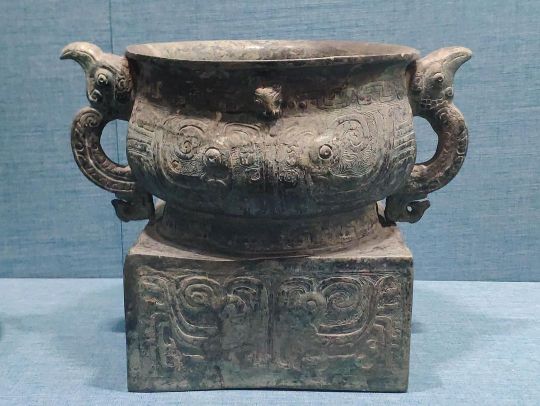
1.西周 青銅鳳鳥紋方座簋 #青銅器 #西周 2.西漢 鎏金銅犀牛、馴犀俑 鎏金銀銅象、馴象俑 #handynasty #鎏金 3.西漢 素面漆耳杯(一組) 漆耳杯 玉耳杯 #漆器 #玉器 4.西漢 “巨羹”銘彩繪雲氣幾何紋漆盤 5.西漢 釉陶釜甑 #陶器 6.新石器時代 刻符玉璧 #玉璧 7.春秋 青銅匜 #匜 8.清 運河圖冊 #qingdynasty #chinesepainting #地圖 #京杭大運河 9.六朝 “北門壁”城磚 明 南京城磚 明 “鎮江府丹徒縣造”城磚 #城磚 10.東漢 “宜子孫”出廓玉璧 #南京 #nanjing #museum #南京博物院 #nanjingmuseum #大江萬古流長江下游文明特展 (在 Nanjing Museum) https://www.instagram.com/p/CnPBl1RSf6R/?igshid=NGJjMDIxMWI=
#青銅器#西周#handynasty#鎏金#漆器#玉器#陶器#玉璧#匜#qingdynasty#chinesepainting#地圖#京杭大運河#城磚#南京#nanjing#museum#南京博物院#nanjingmuseum#大江萬古流長江下游文明特展
0 notes
Photo

The Long Dragon- book two. The story continues. #chinesedragon #dragons #chinesehistory #handynasty #chinesedynasty #historicalfiction #adventurestories #timetravel #strongwomen #comingofage #spystory #mi6 #spymaster #supernatural #ancientgods https://www.instagram.com/p/CjNYKwcKHL3/?igshid=NGJjMDIxMWI=
#chinesedragon#dragons#chinesehistory#handynasty#chinesedynasty#historicalfiction#adventurestories#timetravel#strongwomen#comingofage#spystory#mi6#spymaster#supernatural#ancientgods
0 notes
Photo

😖😫😩🥺 #画文物 #museumdrawing #doodle #表情包 #handynasty #tombsculpture (at University of Toronto) https://www.instagram.com/p/Ch94uDqAfpw/?igshid=NGJjMDIxMWI=
0 notes
Text
This is one of the only terracotta warriors that was found almost completely intact. Note the detail on the bottom of his shoe, showing that grip and traction were considered in footwear even 2,200 years ago.
Each life-size clay warrior was crafted to be completely unique and there are no two terracotta warriors-among the 8,000 total-that are exactly the same.
Shortly after the completion of the tomb in 210-209 BC, it was looted for weapons and burned, causing the roof to collapse, crushing the terracotta warriors. All the other terracotta warriors that are currently on display were painstakingly restored. What's even more remarkable is that the terracotta warriors were originally painted in bright colors by skilled artisans.
Unfortunately, when they were exposed to air and sunlight during the excavation in the 1970s, the colors began to curl up almost immediately and disappeared within minutes.
These terracotta warriors were put in place to guard the tomb of the first emperor of unified China--Qin Shi Huang. To this day, the tomb has yet to be opened. According to ancient historians, the tomb contains an entire kingdom and palace in which the ceilings are decorated with pearls to mimic the night sky. The tomb is also said to contain extremely rare artifacts and has been rigged with crossbows to shoot anyone trying to break in. To keep its location a secret, the workers were entombed with the emperor.
The Han dynasty historian, Sima Qian, also mentioned that inside the tomb, "mercury was used to fashion the hundred rivers, the Yellow River and the Yangtze River, and the seas in such a way that they flowed." Modern tests have indicated extremely high levels of mercury in the surrounding soil.
#terracotta #warriors #unique #tomb #excavation #emperor #China #QinShiHuang #kingdom #handynasty #ancient #history #historical #historians

7 notes
·
View notes
Text

This is one of the only terracotta warriors that was found almost completely intact. Note the detail on the bottom of his shoe, showing that grip and traction were considered in footwear even 2,200 years ago.
Each life-size clay warrior was crafted to be completely unique and there are no two terracotta warriors-among the 8,000 total-that are exactly the same.
Shortly after the completion of the tomb in 210-209 BC, it was looted for weapons and burned, causing the roof to collapse, crushing the terracotta warriors. All the other terracotta warriors that are currently on display were painstakingly restored. What's even more remarkable is that the terracotta warriors were originally painted in bright colors by skilled artisans.
Unfortunately, when they were exposed to air and sunlight during the excavation in the 1970s, the colors began to curl up almost immediately and disappeared within minutes.
These terracotta warriors were put in place to guard the tomb of the first emperor of unified China--Qin Shi Huang. To this day, the tomb has yet to be opened. According to ancient historians, the tomb contains an entire kingdom and palace in which the ceilings are decorated with pearls to mimic the night sky. The tomb is also said to contain extremely rare artifacts and has been rigged with crossbows to shoot anyone trying to break in. To keep its location a secret, the workers were entombed with the emperor.
The Han dynasty historian, Sima Qian, also mentioned that inside the tomb, "mercury was used to fashion the hundred rivers, the Yellow River and the Yangtze River, and the seas in such a way that they flowed." Modern tests have indicated extremely high levels of mercury in the surrounding soil.
#terracotta #warriors #unique #tomb #excavation #emperor #China #QinShiHuang #kingdom #handynasty #ancient #history #historical #historians
0 notes
Photo
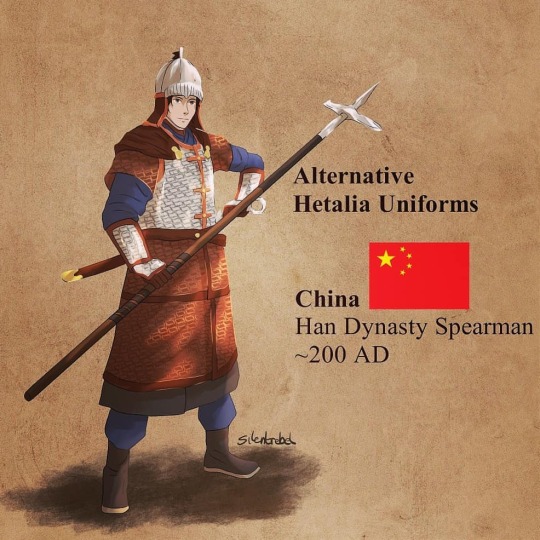
🇨🇳Aph China in Han dynasty dress for my #hetaliauniformau 🔹 ❗How you can support me 🔹Redbubble, ko-fi ☕ etc. ➡️Link in bio: campsite.bio/silentrebel93 🔹My graficdesigns @silentrebel93 🔸Commissions open🔓DM 🔹 🔹 🔹 🔹 #hetalia #aphfanart #hetaliafanart #aphchina #hetaliachina #aphfanart #handynasty #hetaliafanart #hetaliahistory #aphhistory #historicalclothing #ancientchina #asianhistory #historicalarmor #historicaldress #silentrebelart #silentrebel93 https://www.instagram.com/p/CK9TvGyFWJR/?igshid=2ohlmdiun2ul
#hetaliauniformau#hetalia#aphfanart#hetaliafanart#aphchina#hetaliachina#handynasty#hetaliahistory#aphhistory#historicalclothing#ancientchina#asianhistory#historicalarmor#historicaldress#silentrebelart#silentrebel93
55 notes
·
View notes
Photo
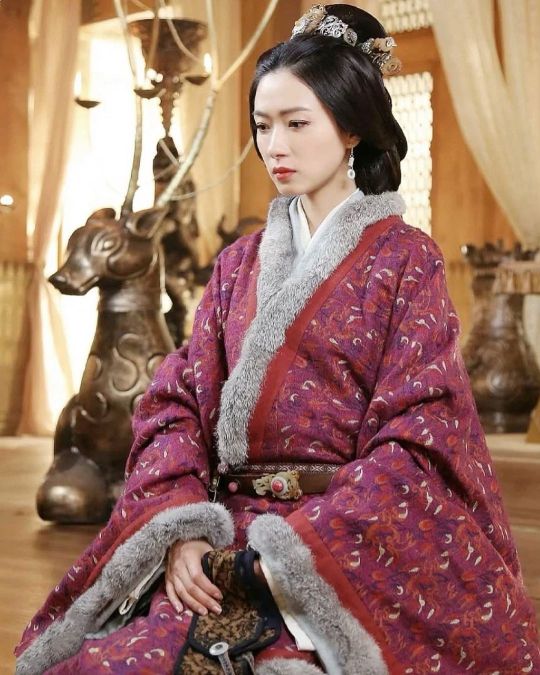
中国🇨🇳东汉传统服饰 Chinese Drama “The Secret Dragon In The Abyss 2018” : Wan Qian as Fu Shou 伏寿. Chinese actress Wan Qian (万茜) with Hanfu in Eastern Han Dynasty. Chinese Drama: 三国机密之潜龙在渊The secret dragon in the abyss (2018) #Hanfu #汉服 #漢服 #中国风 #傳統文化 #handynasty #Chinesestyle #history #traditional #elegant #traditionalculture #Chineseculture #hairstyle #goodvibes #art #photography #Chinesedrama #Cdrama #culture #dress #wuxia #hánphục #asian #setdesign #ancientchina #beauty #wanqian #万茜 #三国机密 #Thesecretdragonintheabyss https://www.instagram.com/p/ChnvUvehc50/?igshid=NGJjMDIxMWI=
#hanfu#汉服#漢服#中国风#傳統文化#handynasty#chinesestyle#history#traditional#elegant#traditionalculture#chineseculture#hairstyle#goodvibes#art#photography#chinesedrama#cdrama#culture#dress#wuxia#hánphục#asian#setdesign#ancientchina#beauty#wanqian#万茜#三国机密#thesecretdragonintheabyss
31 notes
·
View notes
Photo
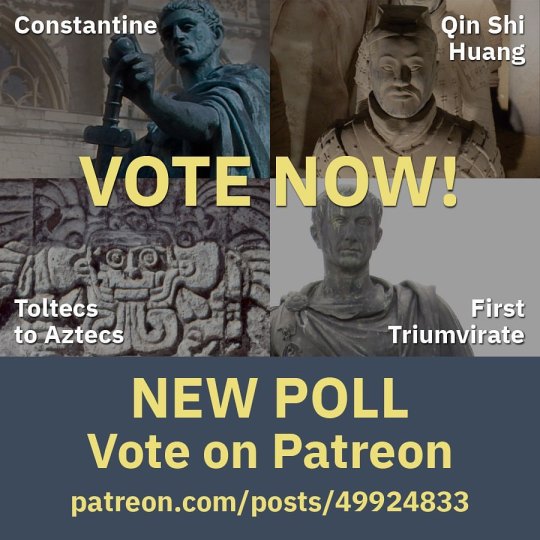
Vote now on Patreon in the April 2021 Omniatlas poll! https://buff.ly/3dZqPjJ Hi everybody—welcome to the April 2021 Omniatlas poll! Omniatlas holds semi-regular polls on Patreon to determine which maps to do next. Anybody who is a Patron of Omniatlas can vote in these polls. The votes in this poll will choose which map series follows the current run of Roman Empire maps (released every Friday). The options are: * Europe: Diocletian to Constantine (285–337) * Europe: First Triumvirate to Augustus (60 BC–6 AD) * East Asia: Qin Shi Huang to Gaozu (247–195 BC) * North America: Toltecs to Aztecs (900–1400) Choose to have the maps continue on with the Roman Empire into the 4th Century, as the Romans enter their last great united phase under Diocletian and Constantine! Or what about going back to an earlier time, to follow the collapse of the Roman Republic during the Third Triumvirate to the founding of the Roman Empire under Augustus, or traveling to the other side of Eurasia to witness the unification of China’s warring states by the Qin and Han dynasties? Or perhaps cross the Atlantic to view the struggle for dominance in Postclassic Mesoamerica? You can vote for one or more of these options on Patreon by going to https://buff.ly/3dZqPjJ. Polling will be open for one week, closing at 9 a.m. on 19 April 2021 (GMT). #omniatlas #history #polls #map #maps #ancienthistory #precolumbian #ancientrome #constantinethegreat #warringstates #qindynasty #handynasty #juliuscaesar #europe #northamerica #eastasia #toltecs #toltec #augustus #romanrepublic #romanempire #mesoamerica #diocletian #lateantiquity #chineseempire #empires #ancient #history #historydegree #patreon (at Constantinople) https://www.instagram.com/p/CNlAzqjgPfl/?igshid=tvi4qqv1yrrf
#omniatlas#history#polls#map#maps#ancienthistory#precolumbian#ancientrome#constantinethegreat#warringstates#qindynasty#handynasty#juliuscaesar#europe#northamerica#eastasia#toltecs#toltec#augustus#romanrepublic#romanempire#mesoamerica#diocletian#lateantiquity#chineseempire#empires#ancient#historydegree#patreon
2 notes
·
View notes
Text
Historians Hate This One Fact About Ancient Fu Dog Statues

Introduction to Fu Dog Statues

Kicking off the captivating tale of the Foo Dog statue, it's important to delve into its roots. Foo Dogs, known as 'Fu Dogs', are classic symbols in Chinese culture, embracing history, craftsmanship, and vibrant folklore. These distinctive statues, formidable yet protective, are traditional elements gracing the entrances of temples, palaces, and homes in China. The statues depict mythical beasts that have an intrinsic appeal due to their rich symbolism and intriguing history, dating back to the Han Dynasty.
Typically, Foo Dog statues look like lions and are often called Chinese guardian lions in the west. This unique lion-like creature, which does not exist in the natural world, combines the formidable fearlessness of a lion with the loyal protectiveness of a dog. It's a potent and fascinating symbol in Chinese culture, amalgamating different elements that appeal to various life aspects.
These sculptures serve multiple purposes, including warding off negative energies, safeguarding spaces, and acting as a talisman for good fortune. Embarking on the exploration of the Foo Dog statue's history, design, and cultural impacts, one uncovers ancient legends and stories that reiterate its timeless value in Chinese culture.
Key Takeaways: Fu Dog Statues
- Fu Dog Statues, also known as Chinese Guardian Lions, have origins dating back to the Han Dynasty.
- These statues are not just artistic pieces but carry deep symbolism of protection, prosperity, and balance in Chinese culture.
- The male and female Fu Dogs represent different aspects, with the male symbolizing dominance and the female symbolizing nurture.
- Fu Dogs play a significant role in Feng Shui, believed to ward off negative energy and bring good luck.
- These statues have been adopted in various Asian cultures and have influenced Western art and architecture.
- A lesser-known fact is the transition of Fu Dog Statues from traditional materials to ceramics during the Tang dynasty, reflecting a cultural shift.
- Fu Dogs are often placed in pairs at entrances of temples and homes, serving as guardians against evil spirits.
- Their global popularity underscores their universal appeal and the widespread appreciation of Eastern cultures.
Definition and Origins

Fu dogs, often known as foo dogs, trace their origins back to the Han dynasty (206 BC - 220 AD) of China. Enigmatic yet captivating, they are not dogs at all, but rather powerful ancient Chinese protective symbols. They are depicted as majestic lion statues, drawing from the Asian cultural reverence for lions as the king of beasts and a symbol of power and protection.
The foo dog lion statue is a fascinating fusion of Buddhist and Taoist cultural influences. It represents the sacred animal lion from Buddhist folklore and embodies the Taoist principles of Yin and Yang, balance and harmony. To the untrained eye, fu dogs may appear identical; however, subtle differences distinguish the male and female figures, symbolizing the complementary forces of Yin and Yang.
Purpose and Symbolism

The foo fu dog statue, prominently visible in the East, is rich in purpose and symbolism. These statues originated from China's Han dynasty, drawing inspiration from ancient lion-based mythology. They were not just mere pieces of art but served an essential function in Chinese society. Their purpose was both spiritual and aesthetic, as these majestic and intricate sculptures were intended to protect individuals and their households from malevolent spirits and people.
Symbolism runs deep in foo fu dog statues. The pair usually consists of a male lion playing with an embroidered ball, symbolic of supremacy over the world, and a female lion nurturing a cub under her paw, representing the cycle of life. The grotesque yet profoundly artistic facial expressions are an embodiment of courage and fearlessness, warding off evil entities.
They also represent power, prosperity, and success, which is why they are ubiquitous in significant structures and residences. Thus, these statues are more than ornamental; they reflect the deeply ingrained Chinese philosophies about balance, protection, and the cyclical nature of life.
The foo fu dog statues are not just pieces of art, but they carry a heavy weight of purpose and symbolism that is deeply rooted in Chinese culture. These statues were originally created during the Han dynasty and have been used for centuries as symbols of protection and prosperity.
• The primary purpose of these statues was to serve as protectors. They were placed at entrances to buildings or homes to ward off evil spirits and people with malicious intent. This protective function is reflected in their fierce facial expressions which embody courage and fearlessness.
• In addition to their protective role, foo fu dog statues also served an aesthetic function. Their intricate designs make them visually appealing, adding a touch of elegance and majesty wherever they are placed.
• Symbolically, the male lion playing with an embroidered ball represents supremacy over the world while the female nurturing a cub under her paw symbolizes life's cyclical nature.
• Another layer of symbolism comes from their appearance; despite being grotesque, these sculptures embody power, prosperity, success - qualities highly valued by Chinese society.
In conclusion:
- Foo Fu Dog Statues represent more than ornamental figures; they reflect profound Chinese philosophies about balance, protection, life cycles.
- Despite having originated several centuries ago during China's Han Dynasty these majestic sculptures remain relevant today due to their deep-rooted significance.
- Their ubiquity in significant structures across East Asia testifies not only to their cultural importance but also underscores how integral these beliefs continue to be within contemporary societies.
Historical Significance
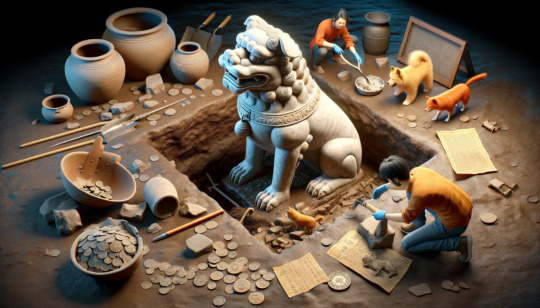
The prominence of the Fu dog, or, more accurately termed, the fu lion statue, can be traced back to Imperial China. Both the Han and Tang dynasties showcased them predominantly, but their significance grew much further during the Ming and Qing dynasties. During these eras, they were seen as the epitome of imperial power, courage, and regality, often strategically placed in important political and religious institutions. Notably, several imperial tombs were adorned with these statues, believed to guard the souls of the deceased rulers against evil and harm in the afterlife.
Han horse-shaped pottery covered with Fu lion designs reveals their artistic significance, highlighting their extensive use as motifs in pottery, paintings, tapestry, and architecture. The fu lion statue also boasted an immense artistic value, symbolizing prosperity and success, often given in the form of gifts to bestow good fortune.
As the culture diffused, so did the prevalence of these statues, spreading across other Asian nations and beyond. Today, they continue to signify courage, prosperity, and protection, maintaining their historical reverence. Their visually captivating aesthetics and deep cultural roots have played an influential role in tastefully blending the past with the present, retaining their historical significance over the centuries.
The Mysterious History of Fu Dogs

Diving deep into the annals of China’s rich and profound history, one will invariably cross paths with numerous stories and legends surrounding large Foo Dog statues. These mystical beasts, also known as Chinese guardian lions, have captivated the interests of scholars, historians, and art enthusiasts alike. Their impressive historical presence in Chinese culture dates back to the Han Dynasty (206 BC–220 AD).
Thought to have profound protective abilities, these large Foo Dog statues were a common sight at imperial palaces, tombs, temples, and homes of nobility. These majestic sculptures served not only as exquisite pieces of art but also as totems believed to ward off menacing spirits.
However, beyond the visual grandeur of large Foo Dog statues, lies a trove of inconceivable mysteries and untold stories waiting to be unearthed. The origins of these mythical creatures have always been a subject of debate, considering how deeply they have been embedded in Chinese folklore and mythology. Some theories suggest that they were inspired by Indian culture, while others propose their roots in Persian or Greek art.
Ancient Chinese epics discuss them as celestial beings, while many believe they were modeled after native dogs—one has to carefully sift through the layers of history to discern the factual evidence from myths. Nonetheless, the fascination with their undeniable historical significance keeps the enigma of Foo Dogs alive in the hearts of historians, writers, and beholders alike.
Ancient Chinese Legends
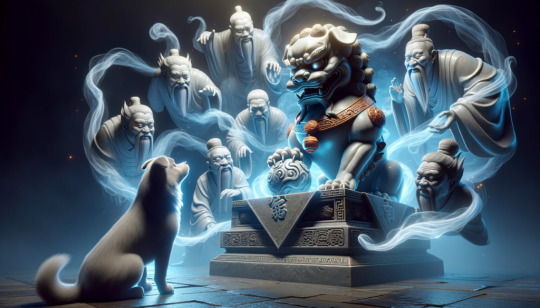
Steeped in deep traditions and narrated through generations, the folklore and legends surrounding the Chinese Foo Dog statues hold an exceptional mystique in ancient Chinese legends. They are not simply decorative sculptures but hold enormous cultural and symbolic significance.
It is said that these ancient guardians originated from the Han Dynasty, around 206 BCE to 220 AD. An intriguing aspect of these legends is that despite their commonly referred name 'Fu Dogs,' they are not dogs at all. Instead, they are mythical beasts, known in Chinese as Shi, symbolizing power and protection.
In ancient Chinese legends, Shi were believed to have an incredibly protective nature and the presence of their statues were seen as potent filters of bad fortune or malicious spirits. They stood as markers of divine power and protection at the gates of imperial palaces, government offices, temples, tombs, and homes of the affluent.
The distinctive features of the Chinese Foo Dog statues, with their menacing expressions and imposing physique, depict a fierce protective spirit. Their legend summons an image of fearless defenders and guardians, an enduring aspect that has been etched deeply in the legacy of ancient Chinese folklore.
Fu Dog Mythology and Folklore

Immerse deeply into the heart of Chinese folklore, and you'll encounter many tales centering around outdoor Fu Dog statues. Also known as Fu dogs or Lion dogs, these creatures have an enticing blend of the lion's majestic power and the loyal canine's protective spirit. Outdoor Fu Dog statues have a strong symbolic presence in many narratives, often credited with warding off evil spirits and welcoming positive energy at the entrances of homes and temples. This is why they are frequently seen as an essential part of Chinese architectural aesthetic, with prominence at the gate of monasteries, temples and palaces, as well as private villas and estates.
The folklore surrounding these mythical beings is rich and varied. Some stories depict them as menacing creatures whose sole purpose is to scare away evil spirits. Others portray them as nurturing creatures connected with fertility and abundance. The Fu dogs, usually depicted in pairs, are thus seen as the perfect balance of yin and yang energies, representing the dual forces that harmoniously regulate the universe's movement.
Often, the male Fu dog is portrayed playing with a ball, symbolizing the world's unity, while the female Fu dog is seen with a cub, symbolizing the cycle of life. Such visual storytelling invokes a sense of wonder, effortlessly tying together elements of nature, cosmology, and human existence in a beautifully succinct pictorial narrative.
Archaeological Evidence
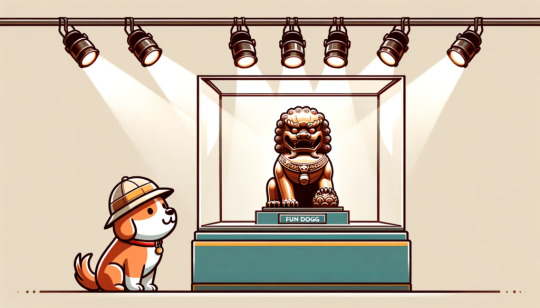
Archaeological excavations in China have provided a trove of clues regarding the history and significance of the Fu Dog or Guardian Lion across various dynasties. Notably, amongst various artefacts, jade foo dogs have emerged as a recurrent theme, standing out for their intricate craftsmanship and rich symbolic value. The earliest evidence of jade foo dogs dates back to the Han Dynasty (206 BC–220 AD), when the practice of carving religious and mythological figures from jade was flourishing. Some historians speculate that the jade foo dogs of the Han era were not just objects of beauty, but also spiritual talismans believed to ward off evil spirits and bring prosperity.
In recent times, the Mausoleum of the Nanyue King in Guangzhou City, unearthed a significant number of jade artifacts including jade foo dogs, dated back to the Western Han period. These discoveries, carefully preserved and studied, help us understand the antiquity of foo dogs in Chinese culture as well as underlying historical craftsmanship techniques.
Further, it sheds light on the socio-cultural dynamics of the period, indicating how such artifacts were predominantly associated with power and protection. The meticulous detailing of these jade foo dogs underscores the high level of finesse that ancient Chinese artisans possessed and the symbolism that such artifacts carried in their era.
The Fact Historians Don't Want You to Know
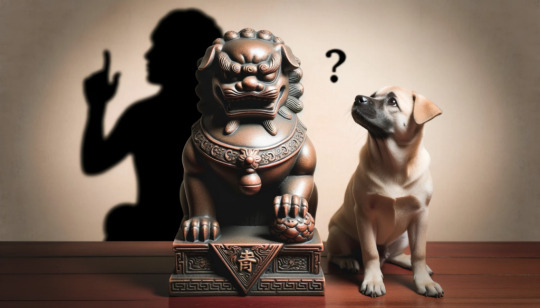
Despite the well-documented history of Fu Dogs in Chinese culture and tradition, there exists a lesser-known fact that ceramic sculptures of these creatures carry a unique significance. When Fu Dog statues first appeared, they were made from bronze, stone, or wood, attributing to both the artistry and the resources available during the different dynasties. However, the craft saw a significant revolution at the onset of the Tang dynasty when foo dogs ceramic gained widespread popularity.
The rise in the foo dogs ceramic during the Tang dynasty is said to be due to the technological advancements in pottery, and ceramics at that time. Simultaneously, this trend reflected the increasing openness of Tang society, gradually moving away from the rigidly hierarchical Shang and Zhou societies and expressing this liberal phase through its art forms.
This historical shift, though quite compelling, is often understated, possibly because it disrupts the more engrained narrative of Fu Dogs as symbols of imperial power and authority. Instead, it highlights a period of evolution, when societal changes influenced art and culture in profound ways. This transformation is encapsulated in the transition from using traditional materials to ceramics for Fu Dog statues, a fact intriguingly unknown to many.
Fu Dog Design and Craftsmanship

Fu Dog Statues are distinguished by a meticulously detailed design and superior craftsmanship. This intricacy can be attributed to the centuries-old Chinese tradition of stone carving and pottery-making. The exquisite detail of Fu Dogs, from their curly mane to the wide-open jaws displaying sharp teeth, embodies not just aesthetics, but also folklore and mysticism tied to the creature.
The common physical features of Fu Dogs include a lion-like appearance, a bushy tail, and a protective and fierce demeanor. Often the Fu Dog sculpture depicts a pair, comprising one male with a ball under his paw (symbolizing the world's unity) and one female, with a cub under her paw (symbolizing nurture and the cycle of life).
Stylistic variations of Fu Dogs vary greatly based on region and era. Despite this, elements like the paw on the symbolic objects, aggressive expressions, and muscular, lion-like bodies remain constant in traditional designs. Fu Dogs are typically carved from marble, jade, bronze, or wood. Every material has its own significance, from purity symbolized by Jade to strength and durability associated with Bronze and Wood.
Sometimes the statues are enhanced with more detailed ornamentation, Oftentimes, the statues are painted or gilded to make them more visually striking. These intricacies in design and craftsmanship highly contribute to Fu Dogs' appreciation as exquisite pieces of art and cultural symbols.
Common Physical Features

Fu Dog statues are typically portrayed as majestic and ferocious mythical beasts, reflecting a harmonious blend of strength, elegance, and spirituality. The most universally recognized physical attributes consist of a bulging, muscular body, thick mane, and widely-opened jaws that reveal sharp, imposing teeth. They are typically shown with one foot raised and placed on an object. This object varies - it might be a cub depicting nurturance if the creature is female, or a ball symbolizing command and authority if the creature is male.
Coupled with the captivating presence of finely detailed fur, the piercing eyes of Fu Dogs contribute to their grandiosity, giving them an aura of wisdom curled with intensity. Another characteristic element of Fu Dogs is the vibrant and intricate adornments and the surface etchings on them.
Read the full article
#ancientChina#artandarchitecture#Asianart#Chineseculture#ChineseGuardianLions#Chinesemythology#culturalheritage#Easternphilosophies#FengShui#FuDogStatues#FuDogStatueshistory#globalinfluence#guardianlions#HanDynasty#TangDynasty
0 notes
Video
youtube
During my Fall 2019 UK Seminars Tour, I stopped in at the British Museum, one of my favorite places in London. Will Henshaw of World Of Martial Arts TV joined me and we made this little video about a fantastic Han Jian in the Museums collection. Enjoy...
#scottmrodell#jianfa#zhongguojianfa#jianshu#duanbing#daoistswordsman#daoistswordarts#daoistsword#hanjian#chinesehistory#handynasty#chineseswordplay#chinesesword#chineseswords#chineseswordsmanship#chineseswordfighting#ukchineseswordfighting#london#uk
13 notes
·
View notes
Photo

Cai Lun courtesy name Jingzhong, was a Chinese eunuch, inventor, and politician of the Han dynasty. He is traditionally regarded as the inventor of paper and the papermaking process, in forms recognizable in modern times as paper (as opposed to papyrus). Although early forms of paper had existed in China since the 2nd century BCE, he was responsible for the first significant improvement and standardization of papermaking by adding essential new materials into its composition.
Follow Us - Facebook | Instagram | LinkedIn
#anspro#officialpage#trivia#cailun#inventor#politician#handynasty#paper#papermaking#improvement#newmaterials#composition
1 note
·
View note